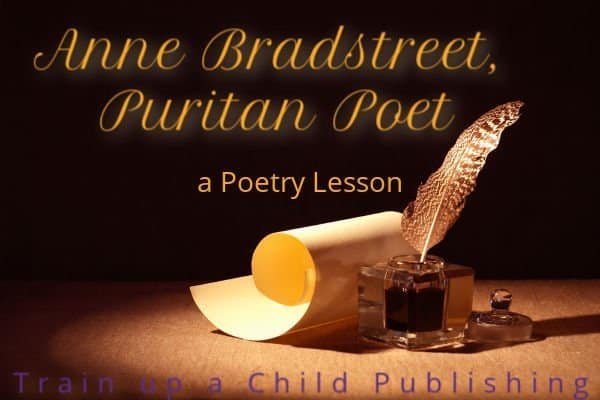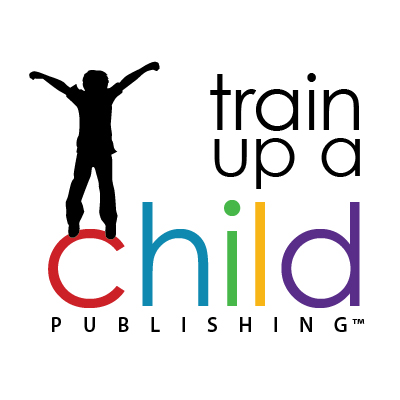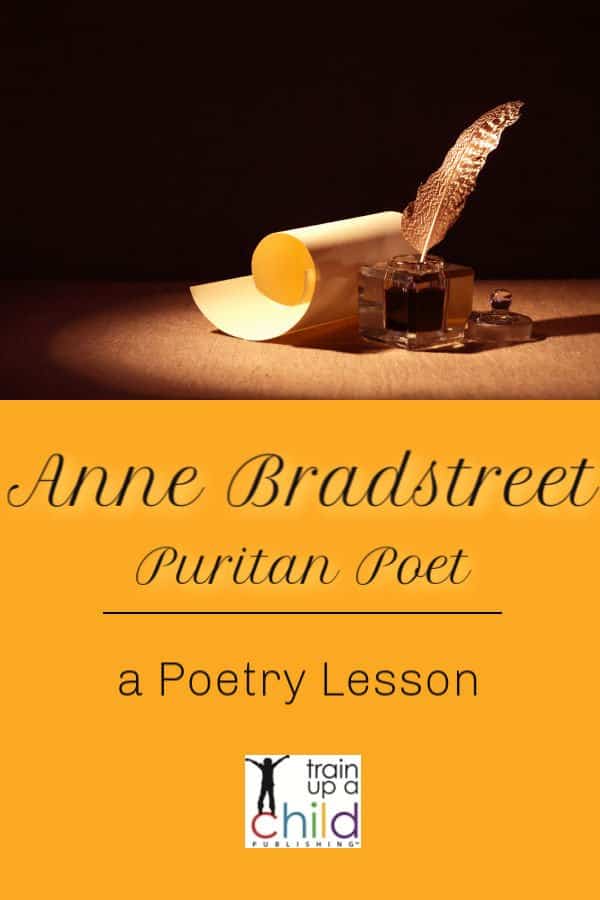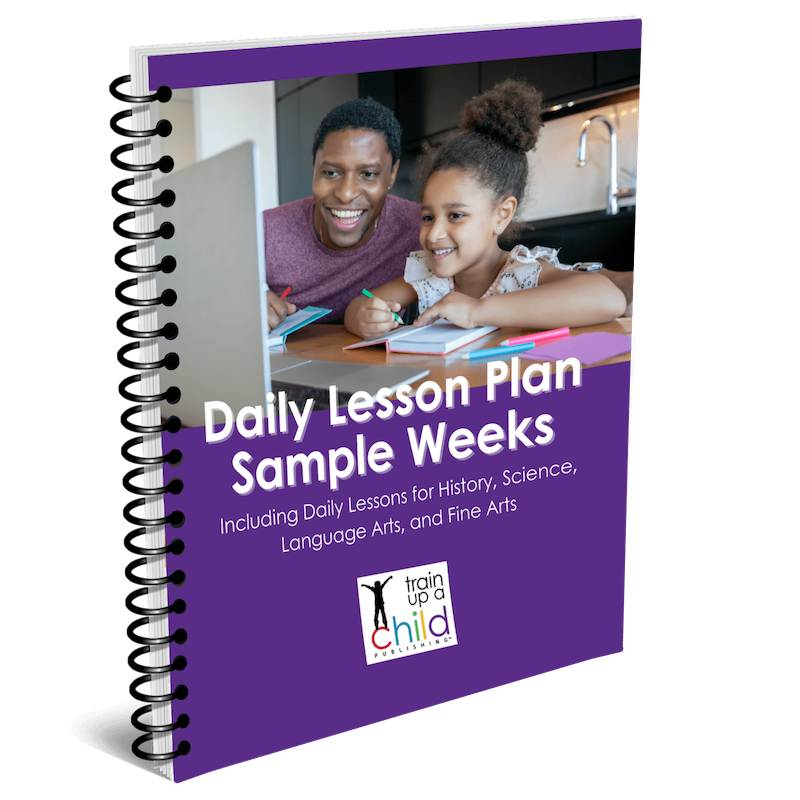Anne Bradstreet, Puritan Poet: a Poetry Lesson

The best way to study poetry? With history. If you’re studying American history, you need to study Anne Bradstreet, a Puritan poet.
Studying poetry is studying the VERY WORDS of real people who lived during the time period you are studying! So, please take advantage of this rich primary source material by including poetry in your history studies. Most importantly, when you are studying the American Colonial period, don’t miss studying the poetry of Anne Bradstreet. Her Puritan Christian faith shined through everything she wrote.
Here’s what Charlotte Mason had to say about studying literature (including poetry, such as Anne Bradstreet’s) along with history:
Literature is hardly a distinct subject, so closely is it associated with history…and it is astonishing how much sound learning children acquire when the thought of an age is made to synchronize with its political and social developments.
A point which I should like to bring before the reader is the peculiar part which poetry plays in making us aware of this thought of the ages, including our own. C
Charlotte Mason, Vol. 6
As Charlotte Mason suggested, poetry helps illuminate history for us by letting us peek over the shoulder of those who came before us! So please include it in your history studies.
And reading Anne Bradstreet’s poetry is especially useful as a shining Puritan example of good character that we want to teach our children to emulate.
Anne Bradstreet, America’s First Poet
The first woman to be published in the U.S., Anne Bradstreet is often considered to be America’s first poet, even though she was actually born in England. Only married for two years, Anne braved the Atlantic and moved with her young Puritan family to Massachusetts Bay, where her husband and father were eventually each governors of this new United States colony.
Anne’s vivid, beautiful poetry is a window into the intentional strength and faith of the Puritan soul in response to the hardship of life in Colonial America. Therefore, it’s not only historically beneficial, but it’s also a useful perspective to us spiritually. Her courage, love for her family, work ethic, and persistence are character qualities we want for our kids.
Below is one of Anne’s poignant poems followed by lesson plan ideas to use for your high school-aged students.
Here followes some verses upon the burning of our house, July 10th, 1666.
by Anne Bradstreet
In silent night when rest I took,
For sorrow neer I did not look,
I waken’d was with thundring nois
And Piteous shreiks of dreadfull voice.
That fearfull sound of fire and fire,
Let no man know is my Desire.
I, starting up, the light did spye,
And to my God my heart did cry
To strengthen me in my Distresse
And not to leave me succourlesse.
Then coming out beheld a space,
The flame consume my dwelling place.And, when I could no longer look,
I blest his Name that gave and took,
That layd my goods now in the dust:
Yea so it was, and so ’twas just.
It was his own: it was not mine;
Far be it that I should repine.He might of All justly bereft,
But yet sufficient for us left.
When by the Ruines oft I past,
My sorrowing eyes aside did cast,
And here and there the places spye
Where oft I sate, and long did lye.Here stood that Trunk, and there that chest;
There lay that store I counted best:
My pleasant things in ashes lye,
And them behold no more shall I.
Under thy roof no guest shall sitt,
Nor at thy Table eat a bitt.No pleasant tale shall ‘ere be told,
Nor things recounted done of old.
No Candle ‘ere shall shine in Thee,
Nor bridegroom’s voice ere heard shall bee.
In silence ever shalt thou lye;
Adieu, Adeiu; All’s vanity.Then streight I gin my heart to chide,
And didst thy wealth on earth abide?
Didst fix thy hope on mouldring dust,
The arm of flesh didst make thy trust?
Raise up thy thoughts above the skye
That dunghill mists away may flie.Thou hast an house on high erect
Fram’d by that mighty Architect,
With glory richly furnished,
Stands permanent tho’ this bee fled.
It’s purchased, and paid for too
By him who hath enough to doe.A Prise so vast as is unknown,
Yet, by his Gift, is made thine own.
Ther’s wealth enough, I need no more;
Farewell my Pelf, farewell my Store.
The world no longer let me Love,
My hope and Treasure lyes Above.
Editor’s Note: there are affiliate links included in this blog post. Should you make a purchase using one of our affiliate links, we might make a small commission on your purchase, at no extra cost to you. Thank you for supporting us in this way!
How to Read Poetry
No matter the age of your students, the following are basic steps to reading poetry, as presented in How to Read a Book: The Classic Guide to Intelligent Reading.
The first half is a must-read for beginning high school students. Not only does it teach your kids to read poetry, but also how to actively read anything. I give you permission right now to only read the first half of the book.
Okay, back to how to read poetry.
First, read the poem through the first time without stopping. Even though there are unfamiliar words and phrases, you will understand much more by first reading the poem through without stopping to figure out the vocabulary.
After that, read the poem through a second time, but this time read it aloud. Poetry’s inherent rhythm brings words and phrases to life.
Now, during the third time reading the poem, you may start asking what the poem is saying.
The more you read it, the more the poem can speak to you.
Teaching poetry to younger students
In true Charlotte Mason fashion, resist the urge to “teach” this poem. Instead, allow the poem to speak directly to your student. And this particular poem will be more suitable for older late/mature elementary students and above.
For elementary students, just focus on reading the poem. If you anticipate your student becoming frightened about your house burning down, remind him that during Colonial times candles were used for light and most household items were of wood, so house fires were much more common than today. (Although we ALWAYS have to be careful of fire, etc…)
For an older elementary or middle school-aged student, read a stanza aloud, one at a time, and have your student narrate (tell back) what s/he has heard. Record your student’s thoughts for each stanza. You may also have your middle/high school student provide a written narration.
After the narration is complete, you may ask your student to describe how the author feels about what happened, especially if this was not included in the original narration. Your student may also ask you questions about the poem, which is fine, but try to be brief in your answers. Even better, have him list his questions and seek the answer first in the poem itself. If your student shows particular interest in any poem, encourage questions, re-reading and further observation.
Of course, younger students will miss the biblical allusions and will focus on the more ‘concrete’ aspects of this poem, as is normal for their stage of development.
You may choose to read other poems by Anne Bradstreet while studying the American Colonial period, as Charlotte Mason advocated reading one poet at a time, for six weeks or more. For the younger set, focus mainly on reading and enjoying the poems.
Teaching poetry to high school students
High school students should initially approach the poem in the same way recommended earlier. First by reading the poem in its entirety, without stopping; then reading the poem a second time, aloud, again without stopping.
Most high school students would benefit by reading this poem through every day for a week or more. As it is rich in biblical allusions and principles and Puritan theology, the discerning student will learn much by re-reading.
Assignment Possibilities for your high school student:
Additional Assignment Ideas from our American Literature High School Course:
For additional reading on Anne Bradstreet:
- Beyond Statliest Marble: The Passionate Femininity of Anne Bradstreet (Leaders in Action)
- Anne Bradstreet: a Guided Tour of the Life and Thought of a Puritan Poet
- To My Husband and Other Poems
For excellent reading concerning the Puritans:
You might be surprised to find out that the Puritans weren’t at all like how they are often portrayed. Read their inspiring prayers in The Valley of Vision and more about their lives in Worldly Saints. I bet you’re going to be surprised that they aren’t the joyless people they were often made out to be!
Anne Bradstreet is a poet you don’t want to miss when you study Colonial America!
So is poetry something you enjoy reading at your house, or do you struggle to include it? Have you ever read Anne Bradstreet’s poetry?




Very interesting! Thanks for the tips!
You’re welcome, Lois!
It’s purchased, and paid for too
By him who hath enough to doe
What a beautiful promise!! I have never heard of this poet but will definitely include her in future studies. Thank you for the great tips on teaching poetry to my kids, especially by age.
Amen, Cheryl! I’m so glad you could discover Anne Bradstreet through my post, and you’re welcome for the tips by age! Thanks for reading and taking the time to share.
Thanks for sharing this poem and the info about teaching poetry. My 13 year old is studying early American history and wants to read biographies of godly women of the time…I think Mrs. Bradstreet will be added to the list, and we’ll find some of her poetry to include. I especially liked the line praising the One who gives and takes away. All our blessings flow from Him, and sometimes we don’t even realize the great number we receive until some are removed.
Hi, Sally, that’s a wonderful idea to have your daughter reading biographies of godly women! Anne Bradstreet is an excellent choice for the Colonial period. I agree with your sentiment exactly. Thank you for sharing and taking the time to comment.
Oh I just read the blog about planning for next year! I’m impressed by the detail in your samples and would LOVE to use your curriculum for 8th grade!
I’m glad my planning post was helpful to you and thrilled to hear that you’d like to use our curriculum for your 8th grader. Thank you for responding!
We love taking the time to integrate poetry into our day and subjects. Your curriculum would be a wonderful way to continue with our middle schoolers!
Hi, Robyn; I loved adding poetry to our history units as well, especially when it’s such a valuable primary source providing insight into a time period. Thank you for your kind comments.
Thank you for sharing this!
You’re welcome, Michelle!
Thank you for sharing this insight into Poetry. I was not sure how to teach poetry to my 14 year old son….now I have some direction.
Hi, Michelle~I’m so glad!
This is beautiful poetry. We are always given the impression that the Puritans were dour and not interested in anything but surviving here in America when they came.
The Poetry by anne Bradstree shows us that that is not so.
Thank you for sharing this with us.
I know! The Puritans have been misunderstood by history. I’m happy that some books tell us the truth about them, and especially that we can learn about the Puritans by reading their own words, such as in this Anne Bradstreet poem. Thanks for stopping by!
I had never read poetry by Anne Bradstreet before. Thank you for this, as well as assignment ideas for older students!
You’re quite welcome, Pati!
Yes; I agree! 🙂
And, it thaws the hearts of the less sensitive. 🙂
Yes, Tammy; I think poetry often does that. Thank you for sharing.
Thank you for introducing me to a poet we have never met.
We focus one a poet per term, usually within the time period. We pick out a poem or two for recitation as well. The sweetest moments are when my daughter sees something and begins to recite. We were at the natural park about a year ago, and she saw a stuffed bald eagle and began reciting “He clasps the crag with crooked hands…”
Tammy, that’s wonderful!! Very sweet! Poetry really speaks to the hearts of some sensitive souls, doesn’t it? I am glad I was able to introduce you to someone you had not yet met! Thanks for taking the time to comment.
Thank you Dana, for this lesson plan. We have read this poem before and found Anne’s courage and hope of her treasure in Heaven amazing. I would love to look at this again with my girls, using your plan. We have occasionally looked at poets who lived in the period of history we are studying, thank you for reminding us to keep doing this.
Thank you, Rachael! I, too, find Anne’s courage and faith amazing! I can’t imagine what a hard life it must have been traveling to American with young children and making a new life for oneself.
For your convenience, and for others who might want to use this lesson plan, below are a few of the biblical references from the puritansermons.com site:
Line 14: I blest his name that gave and took, see Job 1:21
Line 40: Arm of flesh, see 2 Chron. 32:8; Isa. 9:18-20; Jer. 17:4-7
Line 42: Dunghill mists, see Ezra 6:9-12.
Line 43: House on high erect, see 2 Cor. 5:1; Heb. 11:10
Line 48: Enough to doe, ie. enough to do it
Line 54: Treasure lyes Above, see Luke 12:34
Thanks for visiting!